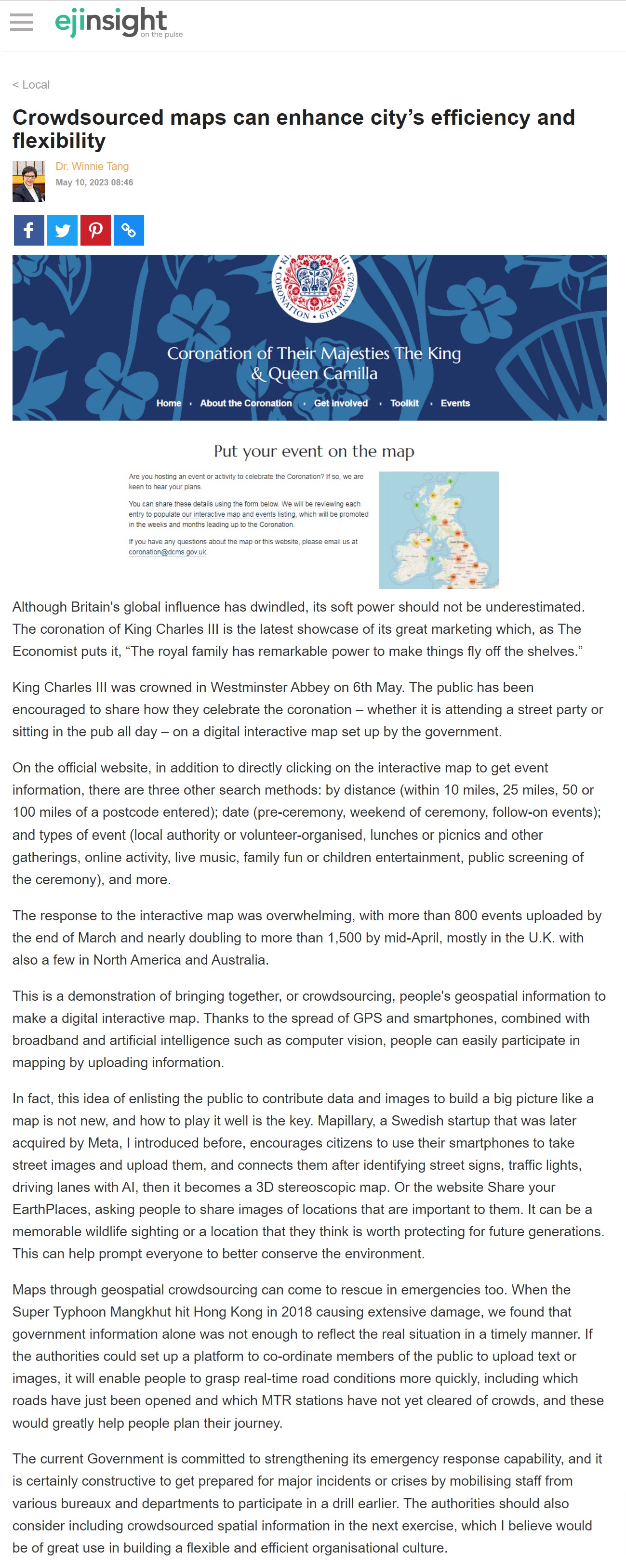網上版請按此

Crowdsourced maps can enhance city's efficiency and flexibility
Although Britain's global influence has dwindled, its soft power should not be underestimated. The coronation of King Charles III is the latest showcase of its great marketing which, as The Economist puts it, "The royal family has remarkable power to make things fly off the shelves."
King Charles III was crowned in Westminster Abbey on 6th May. The public has been encouraged to share how they celebrate the coronation – whether it is attending a street party or sitting in the pub all day – on a digital interactive map set up by the government.
On the official website, in addition to directly clicking on the interactive map to get event information, there are three other search methods: by distance (within 10 miles, 25 miles, 50 or 100 miles of a postcode entered); date (pre-ceremony, weekend of ceremony, follow-on events); and types of event (local authority or volunteer-organised, lunches or picnics and other gatherings, online activity, live music, family fun or children entertainment, public screening of the ceremony), and more.
The response to the interactive map was overwhelming, with more than 800 events uploaded by the end of March and nearly doubling to more than 1,500 by mid-April, mostly in the U.K. with also a few in North America and Australia.
This is a demonstration of bringing together, or crowdsourcing, people's geospatial information to make a digital interactive map. Thanks to the spread of GPS and smartphones, combined with broadband and artificial intelligence such as computer vision, people can easily participate in mapping by uploading information.
In fact, this idea of enlisting the public to contribute data and images to build a big picture like a map is not new, and how to play it well is the key. Mapillary, a Swedish startup that was later acquired by Meta, I introduced before, encourages citizens to use their smartphones to take street images and upload them, and connects them after identifying street signs, traffic lights, driving lanes with AI, then it becomes a 3D stereoscopic map. Or the website Share your EarthPlaces, asking people to share images of locations that are important to them. It can be a memorable wildlife sighting or a location that they think is worth protecting for future generations. This can help prompt everyone to better conserve the environment.
Maps through geospatial crowdsourcing can come to rescue in emergencies too. When the Super Typhoon Mangkhut hit Hong Kong in 2018 causing extensive damage, we found that government information alone was not enough to reflect the real situation in a timely manner. If the authorities could set up a platform to co-ordinate members of the public to upload text or images, it will enable people to grasp real-time road conditions more quickly, including which roads have just been opened and which MTR stations have not yet cleared of crowds, and these would greatly help people plan their journey.
The current Government is committed to strengthening its emergency response capability, and it is certainly constructive to get prepared for major incidents or crises by mobilising staff from various bureaux and departments to participate in a drill earlier. The authorities should also consider including crowdsourced spatial information in the next exercise, which I believe would be of great use in building a flexible and efficient organisational culture.
Dr. Winnie Tang
Adjunct Professor, Department of Computer Science, Faculty of Engineering; Department of Geography, Faculty of Social Sciences; and Faculty of Architecture, The University of Hong Kong